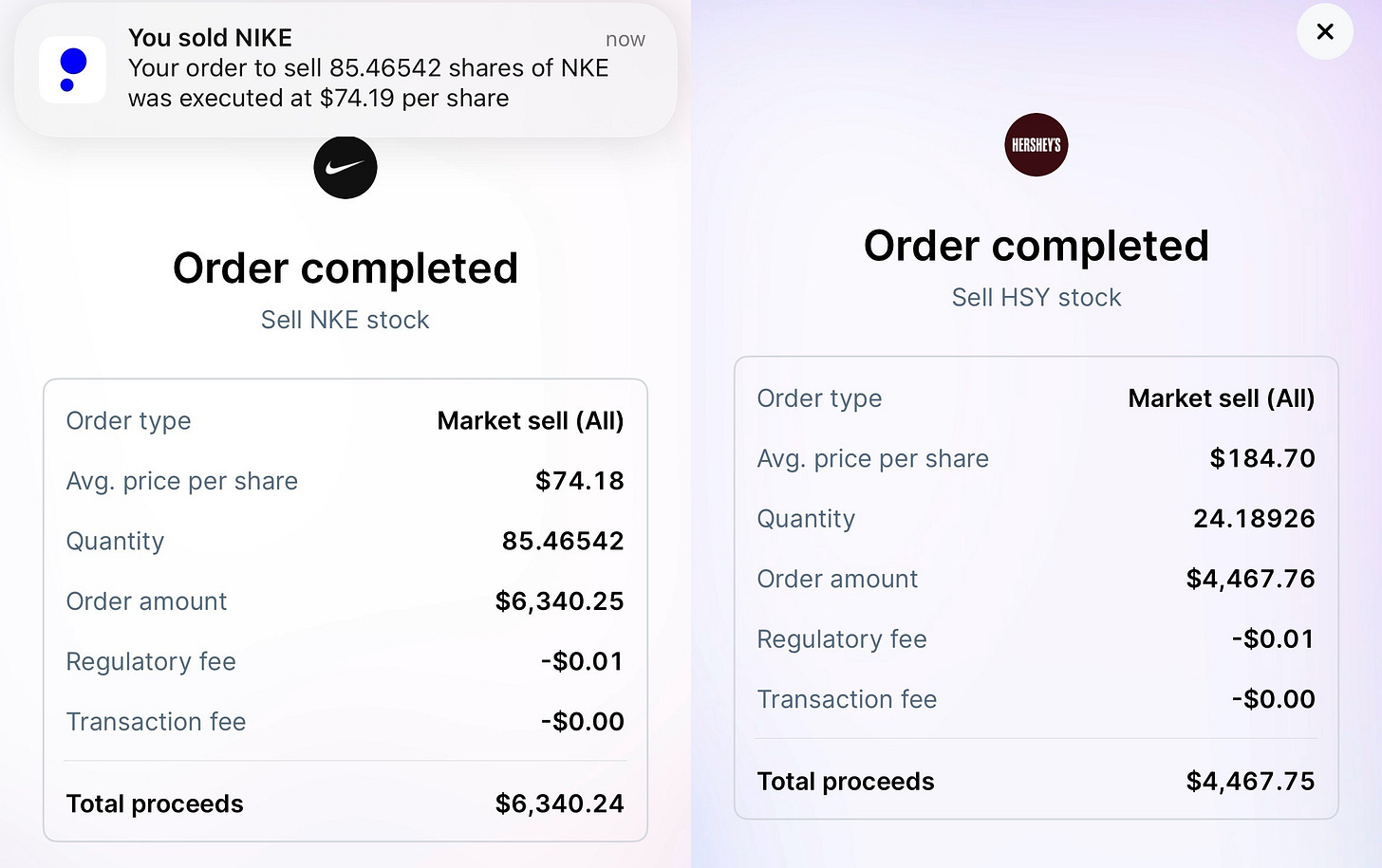
I’m doing what I said I would do.
If you’ve followed this series, you know I’ve spent more than a year inching toward consolidation.
This month, I took the final step.
I sold Nike, Hershey and Starbucks — the last three dividend-paying companies in my taxable account.
A clean break. The end of an era.
Not because they failed me, but because the strategy did.
Nike, Hershey and Starbucks were my babies. They did exactly what they were supposed to do. They paid steady dividends, grew a little and gave me that reassuring sense of progress every quarter.
But unless I held thousands of shares and caught a rare breakout, the returns weren’t going to move the needle. The issue wasn’t the companies, it was the approach.
Owning individual dividend stocks gave me activity, not efficiency. What I need now is a portfolio that works harder than I did — without me spending precious time stock-picking or staring at the ticker.
With that, my long and winding dividend journey comes to an end.
From D-R-I-P to Direction
A 47-cent payout sparked plenty of curiosity. What followed was a disjointed dividend reinvestment plan (D-R-I-P). Two years later, my strategy looks completely different. Here's a quick scroll through my dividend evolution:
💸 I want all the dividends — June 29, 2023
I jumped in wide-eyed and without a plan.
💸 Putting the “O” in Overlap — Jan 18, 2024
Diversification turned into duplication — and I finally noticed.
💸 Re-aligning — April 4, 2024
I started cutting clutter and investing with purpose.
💸 Nearing Our First Milestone — July 11, 2024
Closing in on $1,000 felt like proof that compounding was finally working.
💸Everything Must Go — Sept. 12, 2024
I let go of familiar names and sharpened my portfolio.
I’d held Nike and Hershey since late 2022, watching small profits trickle in: 5 percent on Nike, just half a percent on Hershey.
Capital gains came to $308.14 from Nike, and just $31.99 from Hershey.
That’s exactly why I sold.
Dividends added up to the cost of two date nights — $154.87 from Hershey, $95.52 from Nike.

Starbucks did a bit better.
Since May 2023, it brought in $577.46 in capital gains plus $89.78 in dividends — a total of $667.24. Still, nothing game-changing without significantly more capital.
Now, the Vanguard Total Stock Market ETF (VTI) is the only dividend payer in my taxable account. And that feels right.
No more overlap. No more overthinking.
Selling my babies was me acknowledging that, and finally acting on it.
This wasn’t a panic sale. It was a real-time course correction.
Dividends will keep flowing from VTI and inside my Roth IRA. But the days of tracking each penny by hand on the fridge are long gone.
It was fun while it lasted. Every payout came with a lesson. Each one felt like a quiet win, a nod from future me saying, “Keep going.”
Since the last update, I added $128.54 in dividends, bringing my taxable account’s lifetime total to $1,467.60.
My Roth account has done even better. My lifetime dividends now sit at $3,743.16, with $375.66 since the last update.
I guess crossing $5,000 in dividends marks another milestone.
But the real joy is watching Parker’s accounts take off. She’s the reason I started investing in the first place.
Parker received $134.39 from VYM on June 24, and for the first time, her dividends automatically reinvested into more than one full share — 1.034 to be exact. Now her real compounding begins.
She also earned $53.77 from her VT stake, bumping her lifetime total in that fund to $176.86. With her portfolio restructured, this account is set for rapid growth. For now, Parker’s total dividend earnings across her custodial and Roth accounts now stand at $1,225.25.
She’s catching up to my taxable account, and I couldn’t be prouder.
But my thrill for dividends has faded.
Not because dividends stopped working. They did exactly what they were supposed to do. They provided steady, predictable and reassuring income. Along the way, I outgrew the strategy. Or maybe I just evolved.
Dividend investing taught me discipline and patience. But I’m no longer holding positions out of nostalgia or hope. Now, I want more than predictable. I want exponential growth and asymmetric upside.
This round wasn’t about compounding. It was about closing a chapter.
It was, well, time.
It's dividend time!
This one’s hard to write because it means admitting — publicly — that I was wrong.
It's dividend time!
Since my last portfolio update, I’ve sold three more dividend stocks from my taxable brokerage account.
Disclaimer: The information contained on Money Talks is not intended as, and should not be understood or construed as, financial advice. I am not an attorney, accountant or financial advisor. These are my personal experiences, and neither this website, newsletter nor podcast is a substitute for advice from a qualified professional.







I still love my dividend payers, but I'm at a different place in my strategy. A dividend is often a sign (but not always) a company has reached the point where the best use of its funds is to return some money to shareholders. There are also high-dividend yield payers, but those require more careful monitoring. My non-dividend companies earn their place by having a strong vision for how the money will be spent and their ability to turn risk into upside.
I love that you are teaching Parker about how all of this works and that parking money in an ETF can be a great idea.